In the Heat of the Night (film)
8.8 /10 1 Votes
95% Rotten Tomatoes Genre Crime, Drama, Mystery Country United States | 8/10 IMDb Film series Virgil Tibbs Duration Language English | |||||||||||||||||||||||||||||||||
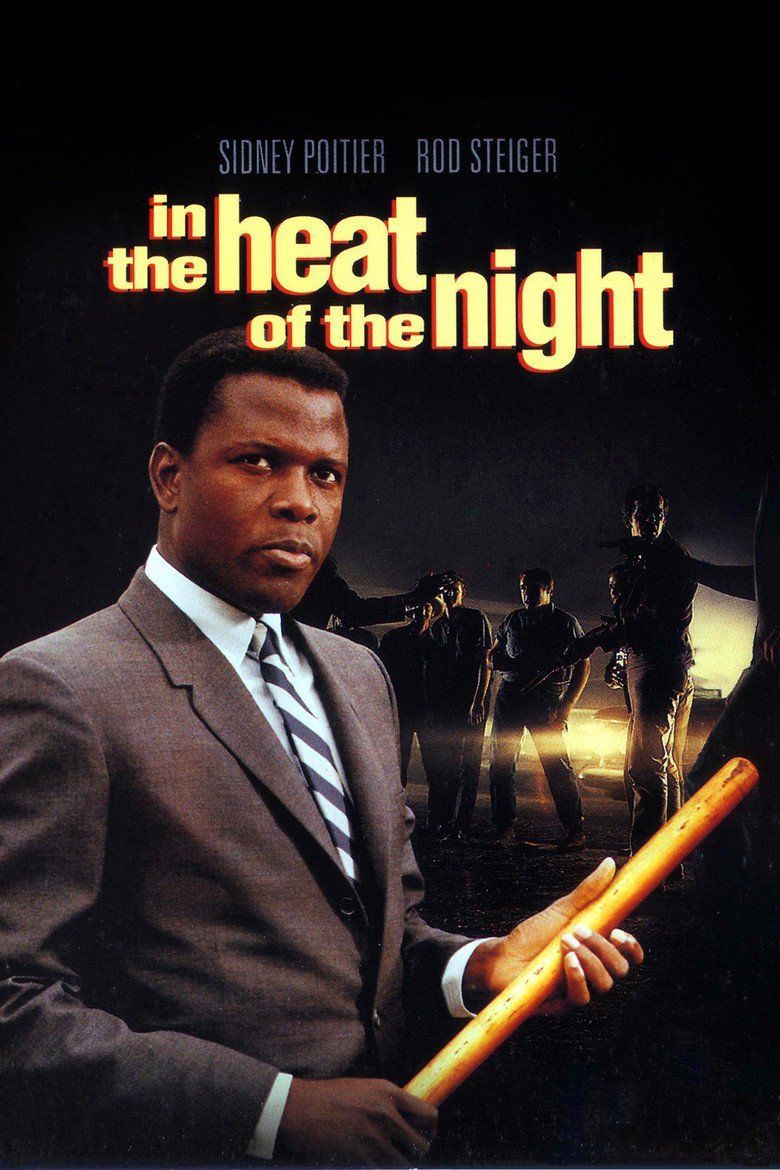 | ||||||||||||||||||||||||||||||||||
Release date August 2, 1967 (1967-08-02) Cast (Det. Virgil Tibbs), (Police Chief Bill Gillespie), (Off. Sam Wood), (Mrs. Leslie Colbert), (Eric Endicott), (Mr. Purdy) Similar movies The Green Mile , The Color Purple , American Gangster , To Kill a Mockingbird , Jaws , The Devil's Advocate Tagline They got a murder on their hands. They don't know what to do with it. | ||||||||||||||||||||||||||||||||||
In the Heat of the Night is a 1967 American mystery drama film directed by Norman Jewison. It is based on John Ball's 1965 novel of the same name and tells the story of Virgil Tibbs, a black police detective from Philadelphia, who becomes involved in a murder investigation in a small town in Mississippi. The movie changes various details found in the book from relatively minor ones (in the book, Tibbs is a police officer in California) to more major (basic details of the murder, including the victim, are different). It stars Sidney Poitier and Rod Steiger, and was produced by Walter Mirisch. The screenplay was by Stirling Silliphant.
Contents
- In the heat of the night 1967 clip 1
- Plot
- Song credit
- Production
- Reception
- Evaluation in film guides
- Home media
- Other appearances
- Preservation
- Accolades
- References

The film won five Academy Awards, including the 1967 awards for Best Picture and Rod Steiger for Best Actor.

The film was followed by two sequels, They Call Me Mister Tibbs! in 1970, and The Organization in 1971. In 1988, it also became the basis of a television series adaptation of the same name.

Although the film was set in the fictional Mississippi town of Sparta (with supposedly no connection to the real Sparta, Mississippi), most of the movie was filmed in Sparta, Illinois, where many of the film's landmarks can still be seen. The quote "They call me Mister Tibbs!" was listed as number 16 on the American Film Institute's 100 Years...100 Movie Quotes, a list of top film quotes. In 2002, the film was selected for preservation in the United States National Film Registry by the Library of Congress as being "culturally, historically, or aesthetically significant".
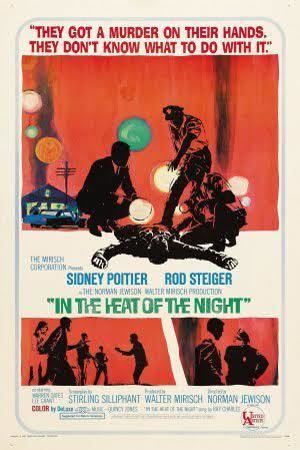
In the heat of the night 1967 clip 1
Plot
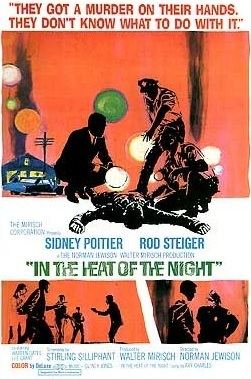
Phillip Colbert, a wealthy industrialist from Chicago, is constructing a factory in Sparta, Mississippi. One night in September 1966, when driving back into town after a meeting at the plantation home of one of Sparta's leading citizens, Eric Endicott, he is murdered. His body is found on the pavement at the front of an alley's entrance onto Main Street by Police Officer Sam Wood at about 3:30 a.m.
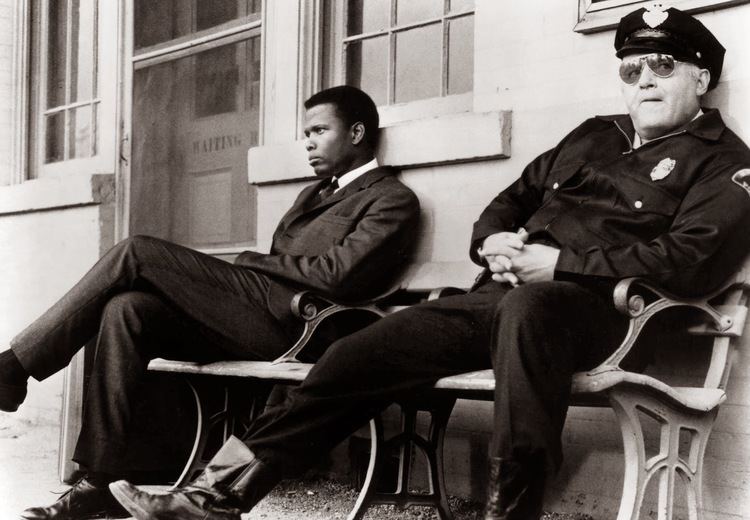
Police Chief Bill Gillespie arrives on the scene where the body has been discovered and takes direct charge of the investigation. A local undertaker and a freelance photographer have been summoned to the scene to assist the police with their investigation. The undertaker tells Gillespie that it is his immediate guess that the death occurred no more than a couple of hours earlier than the time of Wood’s discovery of the body, around 3:00 a.m.
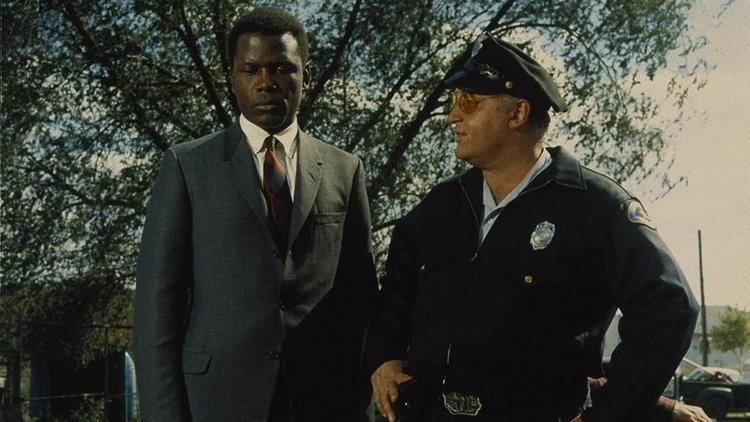
Gillespie, speculating that the crime may have been committed by a transient, orders Wood to verify that the pool hall is closed (its hours had it open until 1:00 a.m.), the streets and alleyways are clear, and that the train and bus depots are clear as well.
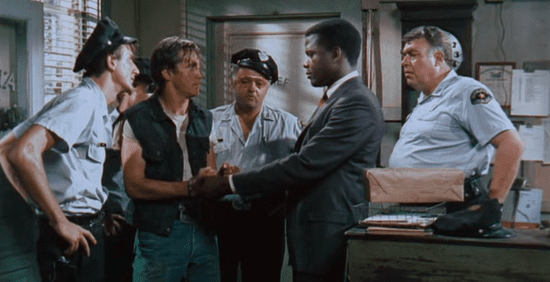
At the town train depot, Wood finds a black man, Virgil Tibbs, sitting quietly with his luggage in a business suit after 3:00 a.m., waiting for what seems to be no specified train. Officer Wood immediately arrests him (at gunpoint), cursorily searches him, and finds more than $200 in cash in his wallet.

Wood takes him into the Sparta police station, where he presents him to Gillespie. Prejudiced against blacks, Gillespie jumps to the conclusion that he has his culprit and attempts to get Tibbs to confess. However, he is embarrassed to learn that Tibbs is a police officer from Philadelphia, Pennsylvania who happens to make more money in a week than Gillespie does in a month.

Gillespie phones Tibbs' chief to confirm the story. The chief informs Gillespie that Tibbs is his top homicide investigator and recommends that Tibbs stay and assist the investigation. Tibbs wants nothing more than to leave as quickly as possible, and Gillespie politely tells the chief that Tibbs' assistance won't be necessary. But as Tibbs prepares to head back to the train station, Gillespie swallows his pride and asks for help. Tibbs relents.
Leslie Colbert, the victim's widow, already frustrated by the ineptitude of the local police, is impressed by Tibbs' expertise when he clears another wrongly accused suspect whom Gillespie has arrested on circumstantial evidence. She threatens to stop construction on the much needed factory unless Tibbs leads the investigation. Unwilling to accept help, but under orders from the town's mayor, Gillespie talks a reluctant Tibbs into working on the case.
Despite the rocky start to their relationship, the two policemen are compelled to respect each other as they are forced to work together to solve the crime. Tibbs initially suspects wealthy plantation owner Eric Endicott, a racist who publicly opposes the new factory, as its workforce will consist primarily of black people. When Tibbs attempts to interrogate Endicott about Colbert, Endicott slaps him in the face, but Tibbs instantly slaps him back ("the slap heard round the world"), which leads to Endicott sending a gang of hooligans after Tibbs. Gillespie rescues him from the fight and orders him to leave town for his own safety, but Tibbs is convinced he is on the trail of the murderer, and refuses to leave until he has solved the case.
Tibbs' examination of Colbert's body has already placed the murder much earlier in the night than either Gillespie or the Sparta police had initially thought. He examines Colbert's car, and deduces that it was used to drive the dead man's body back from an as yet unknown location where Colbert was actually killed. Tibbs asks Wood to retrace his steps from his patrol on the night of the murder. Tibbs knows that an earlier time of death for Colbert means that Colbert's body was driven around Sparta and dumped into an alley while Wood was on patrol.
Tibbs and Gillespie accompany Wood on his patrol route, stopping at a diner where the counterman, Ralph Henshaw, refuses to serve Tibbs. When Tibbs notices that Wood has deliberately changed his route, Gillespie starts suspecting Wood of the crime. Tibbs indicates that he knows why Sam has changed his route but will not disclose the reason to Gillespie.
When Gillespie discovers that Wood made a sizable deposit into his bank account the day after the murder (which Wood claims is gambling winnings) and Lloyd Purdy, a local, files charges against Wood for getting his 16-year-old sister Delores pregnant, Gillespie arrests Wood for the murder, despite Tibbs' protests. Purdy is offended that Tibbs, a black man, was present for his sister's interrogation about her sexual encounter with Wood, and he gathers a mob to get his revenge on Tibbs.
Tibbs is able to clear Wood by finding the original murder scene, the site where Colbert's factory will be built, and pointing out that Sam would not have been able to drive his police patrol car and the victim's car at the same time. Tibbs also admits that he knew immediately that Wood changed his route not to hide being a murderer, but to hide being a peeping Tom (peeping on Delores Purdy, who herself is an exhibitionist), and declined to publicly reveal this in order to spare Wood embarrassment.
Acting on a hunch, Tibbs tracks down the local back-room abortionist, who reveals that someone had paid for Delores to have an abortion. When Delores arrives, Tibbs pursues her outside, where he is confronted by the murderer, Henshaw. Purdy's mob has tracked down Tibbs and is holding him at gunpoint when he proves to Purdy that it was Henshaw, not Wood, who got Delores pregnant.
Henshaw shoots Purdy dead before being disarmed by Tibbs. Henshaw is arrested and confesses to the murder of Colbert. He had robbed Colbert to gain money to pay for Delores's abortion but had accidentally killed him in the process.
His job done, Tibbs finally boards the Gulf, Mobile & Ohio train out of town, after being bid farewell by a now respectful Gillespie, "Virgil, . . you take care, . . you hear."
Song credit
Production
The film contains a famous scene in which Tibbs and Gillespie visit the home of Eric Endicott to question him, following Tibbs' discovery of trace evidence in the murder victim's car (a piece of osmunda). Upon realizing that Tibbs is suggesting he murdered Colbert, Endicott slaps Tibbs, whereupon Tibbs slaps him back. Reportedly, Tibbs's action was originally omitted from the screenplay, which stayed true to the novel with Tibbs not reacting to the slap. However, when Poitier read the script, he was purportedly uncomfortable with that reaction, as it was not true to the values his parents instilled in him. He requested that the producers alter the scene to Tibbs slapping Endicott back. This was important because of the ongoing battle for civil rights, which was still raging in 1967, despite the passage of the Civil Rights Act of 1964. This was one of the first times in any major motion picture when a black man reacted to provocation from a white man in such a way.
Referring to the scene Poitier said, "[The scene] was almost not there. I said, 'I'll tell you what, I'll make this movie for you if you give me your absolute guarantee when he slaps me I slap him right back and you guarantee that it will play in every version of this movie.' I try not to do things that are against nature." However, Poitier's version of the story is contradicted by Mark Harris in his book, Pictures at a Revolution. Harris states that copies of the original draft of the screenplay that he obtained clearly contain the scene as filmed, which is backed up by Jewison and Silliphant.
The film is also important for being the first major Hollywood film in color that was lit with proper consideration for a person of African descent. Haskell Wexler recognized that standard strong lighting used in filming tended to produce too much glare on that kind of dark complexion and rendered the features indistinct. Accordingly, Wexler toned it down to feature Poitier with better photographic results.
Reception
In contrast to films like The Chase and Hurry Sundown, which offered confused visions of the South, In the Heat of the Night offered a tough, edgy vision of a Southern town that seemed to hate outsiders more than itself, a theme reflecting the uncertain mood of the time as the Civil Rights Movement attempted to take hold. On this count, the film became an overnight hit.
In a San Francisco pre-screening, Jewison was concerned when the young audience was laughing at the film as if it were a comedy. The audience's stunned reaction to the famous slapping scene convinced Jewison that the film was effective as drama. That scene helped make the film so popular for audiences, finally seeing the top black film actor physically strike back against bigotry, that the film earned the nickname, Super-spade Versus the Rednecks. During the film's initial run, Steiger and Poitier occasionally went to the Capitol Theatre in New York to amuse themselves seeing how many black and white audience members there were, which could be immediately ascertained by listening to the former cheering Tibbs's retaliatory slap and the latter whispering "Oh!" in astonishment.
Canadian director Jewison wanted to tell a story of a white man and a black man working together in spite of difficulties. He also hated the way black Americans were treated by the white establishment at the time. Jewison, Poitier, and Steiger worked together and got along well during the filming, but Jewison had problems with the Southern authorities, and Poitier had reservations about coming south of the Mason–Dixon Line for filming. However, despite their reservations, Jewison decided to film part of the film in Dyersburg (Endicott's house) and Union City, Tennessee, anyway while the rest was filmed in Sparta, Chester (Harvey Oberst chase scene), and Freeburg (Compton's diner), Illinois.
Jewison said that this film proved a conviction he had held for a long time: "It's you against the world. It's like going to war. Everybody is trying to tell you something different and they are always putting obstacles in your way."
Then-freshman critic Roger Ebert in 1967 gave In the Heat of the Night a positive review and placed it at number ten on his top ten list of 1967 films. AD Murphy of Variety magazine felt it was a good but uneven film.
With the release of the film in the United States in August, Poitier was starring in two movies simultaneously at the box office, as To Sir, with Love had been released the previous June.
The film, as of July 2017, holds a 96% "Certified Fresh" rating on the review aggregate website Rotten Tomatoes, out of 44 reviews collected with an average rating of 8.2 out of 10. It's consensus states, "Tense, funny, and thought-provoking all at once, and lifted by strong performances from Sydney Poitier and Rod Steiger.
Evaluation in film guides
Steven H. Scheuer's Movies on TV (1972–73 edition) gives In the Heat of the Night its highest rating of 4 stars, recommending it as an "[E]xciting, superbly acted and directed film about prejudice, manners and morals in a small Mississippi town", with the concluding sentences stating, "[D]irector Norman Jewison does an outstanding job in creating the subsurface tension of life in a 'sleepy' Southern town, and the supporting performances are uniformly fine. A first-rate film in all respects." Leonard Maltin's TV Movies & Video Guide (1989 edition) follows Scheuer's example with its own highest rating of 4 stars, concluding that "[M]arvelous social thriller hasn't dated one bit—tough, funny, and atmospheric, with unbeatable acting and splendid Quincy Jones score. Five Oscars include Best Picture..."
Mick Martin's & Marsha Porter's DVD & Video Guide (2007 edition) also puts its rating high, at 4 stars (out of 5), finding it "[A] rousing murder mystery elevated by the excellent acting of Rod Steiger and Sidney Poitier."
British references likewise show high regard for the film, with David Shipman in his 1984 The Good Film and Video Guide giving 3 (out of 4) stars, noting that "[A]s mystery or detective story this film is only fair but it has enormous tension. Within its given framework, it is good on the colour question. There is tension in the eyes of the black (Sidney Poitier), who happens to be a homicide officer, and malevolence in those of the local police chief (Rod Steiger). These are two remarkable performances, well supported by Warren Oates, Lee Grant and Larry Gates."
Home media
In the Heat of the Night was first released on DVD in 2001. In 2010, the film was digitized in High Definition (1080i) and broadcast on MGM HD.
In 2014, MGM released the film on Blu-ray.
Other appearances
In episode 6 of Doctor Who's "Web of Fear", a poster for this film is shown in the background, with the movie title replaced by the words 'Block-Busters', presumably for copyright reasons.
Preservation
The Academy Film Archive preserved In the Heat of the Night in 1997.
Accolades
In the Heat of the Night was nominated for seven Academy Awards, winning five. They are as follows:
American Film Institute recognition
References
In the Heat of the Night (film) WikipediaIn the Heat of the Night (film) IMDbIn the Heat of the Night (film) Rotten TomatoesIn the Heat of the Night (film) themoviedb.org
